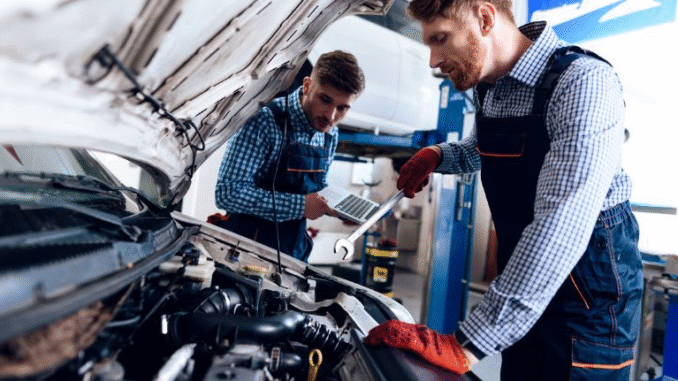
Top Car Maintenance Tips to Keep Your Vehicle Running Smoothly in 2025
Maintaining your vehicle is more important than ever in 2025, as cars have become more advanced, more connected, and more essential to our daily lives. Whether you drive a traditional gasoline-powered car, a hybrid, or a fully electric vehicle (EV), keeping it in top condition ensures safety, performance, and long-term savings.
Here are the top car maintenance tips to help your vehicle run smoothly and reliably in 2025.
1. Stick to a Regular Maintenance Schedule
One of the simplest yet most effective ways to keep your vehicle in good condition is by following the manufacturer’s recommended maintenance schedule. This can be found in your vehicle’s owner’s manual or onboard infotainment system.
Key Scheduled Services Include:
- Oil changes (for combustion engines or hybrids)
- Brake inspections
- Fluid level checks
- Tire rotations
- Battery inspections (including EV batteries)
Most modern cars in 2025 also have smart maintenance reminders that alert you when service is due, making it easier than ever to stay on top of car care.
2. Monitor Your Tires Regularly
Your tires are your car’s only contact with the road, so keeping them in good shape is essential for both safety and performance.
Essential Tire Tips:
- Check tire pressure monthly. Use the correct PSI listed on the door frame or in the manual.
- Rotate your tires every 6,000 to 8,000 miles to ensure even wear.
- Inspect for wear and tear, bulges, or punctures.
- Check alignment and balancing, especially if you feel vibration or pulling.
Using smart tire pressure monitoring systems (TPMS), now standard in many 2025 models, can help you keep track effortlessly.
3. Keep Fluids at Proper Levels
Even in an era of advanced vehicles, fluid management is still critical. Internal combustion and hybrid vehicles need routine fluid checks, while electric vehicles still use some key fluids for performance.
Key Fluids to Monitor:
- Engine oil
- Brake fluid
- Coolant
- Transmission fluid
- Windshield washer fluid
EVs may require coolant system checks to prevent battery overheating. Always use fluids recommended for your car’s make and model.
4. Don’t Ignore Warning Lights
Modern vehicles are equipped with sophisticated onboard diagnostics systems. When a warning light appears on your dashboard, it’s your vehicle’s way of telling you something needs attention.
Common Lights to Watch:
- Check Engine Light
- Battery Warning
- ABS (Anti-lock Braking System)
- TPMS (Tire Pressure Monitoring)
- Oil Pressure
In 2025, many vehicles allow remote diagnostics via apps or built-in AI assistants that can interpret warning lights and suggest steps. Don’t ignore these warnings—early detection prevents costly repairs.
5. Inspect Your Brakes Often
Your brakes are crucial to your safety. Squeaking noises, reduced responsiveness, or longer stopping distances are all signs your brakes may need service.
Regular Brake Checks Should Include:
- Brake pad thickness
- Rotor condition
- Brake fluid level and quality
- Caliper performance
If your car features regenerative braking (common in hybrids and EVs), it still needs inspection. Regenerative systems reduce wear but do not eliminate the need for service.
6. Maintain a Healthy Battery
Battery issues are one of the top causes of breakdowns, especially in colder or very hot climates.
For Gas or Hybrid Vehicles:
- Check for corrosion on terminals.
- Ensure tight connections.
- Replace the battery every 3–5 years.
For Electric Vehicles (EVs):
- Monitor battery health via the vehicle’s app or dashboard.
- Avoid frequent full charges or deep discharges to extend battery life.
- Use smart charging features to schedule off-peak charging and manage heat.
EV batteries are built to last, but proper charging habits can significantly increase longevity.
7. Wash and Protect Your Vehicle
Car maintenance isn’t just mechanical—it’s also cosmetic. Regular washing and detailing not only keep your car looking good but also protect its finish from damage.
Tips for Exterior Maintenance:
- Wash your car at least twice a month.
- Wax or ceramic coat every 3–6 months.
- Remove bird droppings and tree sap promptly—they damage paint.
Interior maintenance is just as important. Clean dashboards, seats, and floors to prevent wear and odors. UV protection sprays can keep plastics and leather from cracking.
8. Update Your Software and Navigation Systems
Modern vehicles in 2025 often have over-the-air (OTA) updates for infotainment, safety, and performance systems.
Software Maintenance Tips:
- Check for system updates regularly.
- Update navigation maps to avoid wrong directions.
- Ensure your ADAS (Advanced Driver Assistance Systems) are running the latest software.
Some manufacturers even offer performance boosts or feature unlocks through software updates—another reason to stay current.
9. Drive Smart and Smooth
Your driving habits directly affect your car’s condition. Aggressive driving increases wear and tear, lowers fuel efficiency, and puts stress on engine and brake components.
Good Driving Habits Include:
- Smooth acceleration and braking
- Avoiding potholes and rough roads
- Not overloading your vehicle
- Letting the engine warm up slightly in cold weather
For EV drivers, smooth driving also maximizes battery efficiency and range.
10. Keep Your Car Covered or Garaged
If possible, keep your vehicle in a garage or under a car cover when not in use. This protects your vehicle from sun, rain, dust, and pollutants.
Benefits of covered parking:
- Preserves paint and finish
- Reduces interior fading
- Protects electronics and sensors
- Helps maintain resale value
In cities, even using underground parking or shaded spots can make a difference.
Conclusion
Keeping your car running smoothly in 2025 doesn’t require being a mechanic—it just takes consistency, awareness, and the help of your vehicle’s smart tools. Whether you’re driving a sleek electric model or a traditional gas-powered car, these top car maintenance tips will help you avoid breakdowns, improve safety, and get the most out of your investment.
Make car care a routine, not a reaction. Your car—and your wallet—will thank you.